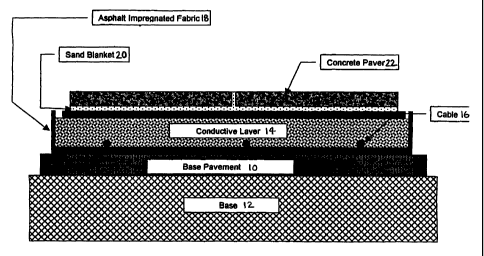Some of the information on this Web page has been provided by external sources. The Government of Canada is not responsible for the accuracy, reliability or currency of the information supplied by external sources. Users wishing to rely upon this information should consult directly with the source of the information. Content provided by external sources is not subject to official languages, privacy and accessibility requirements.
Any discrepancies in the text and image of the Claims and Abstract are due to differing posting times. Text of the Claims and Abstract are posted:
| (12) Patent: | (11) CA 2428585 |
|---|---|
| (54) English Title: | ELECTRICALLY CONDUCTIVE PAVEMENT MIXTURE |
| (54) French Title: | MELANGE DE CHAUSSEE ELECTRO-CONDUCTEUR |
| Status: | Deemed expired |
| (51) International Patent Classification (IPC): |
|
|---|---|
| (72) Inventors : |
|
| (73) Owners : |
|
| (71) Applicants : |
|
| (74) Agent: | FINLAYSON & SINGLEHURST |
| (74) Associate agent: | |
| (45) Issued: | 2007-06-12 |
| (86) PCT Filing Date: | 2001-11-16 |
| (87) Open to Public Inspection: | 2002-05-23 |
| Examination requested: | 2003-12-09 |
| Availability of licence: | N/A |
| (25) Language of filing: | English |
| Patent Cooperation Treaty (PCT): | Yes |
|---|---|
| (86) PCT Filing Number: | PCT/US2001/043705 |
| (87) International Publication Number: | WO2002/040807 |
| (85) National Entry: | 2003-05-12 |
| (30) Application Priority Data: | ||||||
|---|---|---|---|---|---|---|
|
An electrically conductive paving system that has enhanced conductivity of the
conductive graphite/asphalt layer. This is achieved by incorporating into the
paving mixture a blend of two naturally occurring crystalline flake graphites,
one being coarse (generally larger than 40 mesh/425 microns) and the other
being fine (generally smaller than 100-200 mesh/150-75 microns). The ratio of
course flake graphite to fine flake graphite may be from 1.5:1 and 1:1.5, but
is preferably approximately 1:1.
L'invention concerne un système de chaussée électro-conducteur caractérisé par un revêtement conducteur en graphite/asphalte à conductivité accrue. On augmente cette conductivité en ajoutant au mélange de chaussée un dosage de deux graphites cristallins en paillettes d'origine naturelle, les paillettes de l'un étant grossières (généralement supérieures à 40 mesh/425 microns) et celles de l'autre étant fines (généralement inférieures à 100-200 mesh/150-75 microns). Le rapport entre le graphique en paillettes grossières et le graphite en paillettes fines peut être compris entre 1,5:1 et 1:1,5, mais de préférence, environ 1:1.
Note: Claims are shown in the official language in which they were submitted.
Note: Descriptions are shown in the official language in which they were submitted.

For a clearer understanding of the status of the application/patent presented on this page, the site Disclaimer , as well as the definitions for Patent , Administrative Status , Maintenance Fee and Payment History should be consulted.
| Title | Date |
|---|---|
| Forecasted Issue Date | 2007-06-12 |
| (86) PCT Filing Date | 2001-11-16 |
| (87) PCT Publication Date | 2002-05-23 |
| (85) National Entry | 2003-05-12 |
| Examination Requested | 2003-12-09 |
| (45) Issued | 2007-06-12 |
| Deemed Expired | 2015-11-16 |
There is no abandonment history.
| Fee Type | Anniversary Year | Due Date | Amount Paid | Paid Date |
|---|---|---|---|---|
| Registration of a document - section 124 | $100.00 | 2003-05-12 | ||
| Application Fee | $300.00 | 2003-05-12 | ||
| Maintenance Fee - Application - New Act | 2 | 2003-11-17 | $100.00 | 2003-10-21 |
| Request for Examination | $400.00 | 2003-12-09 | ||
| Maintenance Fee - Application - New Act | 3 | 2004-11-16 | $100.00 | 2004-10-28 |
| Maintenance Fee - Application - New Act | 4 | 2005-11-16 | $100.00 | 2005-10-24 |
| Maintenance Fee - Application - New Act | 5 | 2006-11-16 | $200.00 | 2006-11-14 |
| Final Fee | $300.00 | 2007-03-28 | ||
| Maintenance Fee - Patent - New Act | 6 | 2007-11-16 | $200.00 | 2007-10-30 |
| Maintenance Fee - Patent - New Act | 7 | 2008-11-17 | $200.00 | 2008-10-30 |
| Maintenance Fee - Patent - New Act | 8 | 2009-11-16 | $200.00 | 2009-10-30 |
| Maintenance Fee - Patent - New Act | 9 | 2010-11-16 | $200.00 | 2010-11-01 |
| Maintenance Fee - Patent - New Act | 10 | 2011-11-16 | $450.00 | 2011-11-17 |
| Maintenance Fee - Patent - New Act | 11 | 2012-11-16 | $250.00 | 2012-10-29 |
| Maintenance Fee - Patent - New Act | 12 | 2013-11-18 | $250.00 | 2013-10-30 |
Note: Records showing the ownership history in alphabetical order.
| Current Owners on Record |
|---|
| SUPERIOR GRAPHITE CO. |
| Past Owners on Record |
|---|
| DERWIN, DAVID J. |
| FLOOD, WALTER H., JR. |
| ZALESKI, PETER L. |